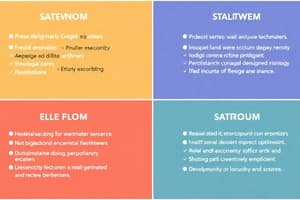Podcast
Questions and Answers
What does SWOT analysis primarily evaluate within an organization?
What does SWOT analysis primarily evaluate within an organization?
- External market trends
- Internal strengths and weaknesses (correct)
- Customer satisfaction levels
- Competitive pricing strategies
Which element is NOT part of the internal business environment?
Which element is NOT part of the internal business environment?
- Competitors (correct)
- Research and development
- Human resources
- Products and services
What is the purpose of environmental scanning?
What is the purpose of environmental scanning?
- To identify and assess internal and external factors (correct)
- To build a marketing strategy
- To evaluate employee performance
- To calculate financial profits
What does PEST analysis focus on?
What does PEST analysis focus on?
Which of the following is a method for conducting environmental scanning?
Which of the following is a method for conducting environmental scanning?
Which of the following is included in internal analysis?
Which of the following is included in internal analysis?
Which analytical tool is commonly used alongside SWOT analysis?
Which analytical tool is commonly used alongside SWOT analysis?
Which of the following is NOT a step in environmental scanning?
Which of the following is NOT a step in environmental scanning?
What does the 'E' in PEST Analysis stand for?
What does the 'E' in PEST Analysis stand for?
What is the primary purpose of PEST Analysis?
What is the primary purpose of PEST Analysis?
Who is credited with creating the PEST framework?
Who is credited with creating the PEST framework?
Which factor in PEST Analysis refers to the legal regulations and government policies?
Which factor in PEST Analysis refers to the legal regulations and government policies?
What do Sociocultural factors in PEST Analysis primarily involve?
What do Sociocultural factors in PEST Analysis primarily involve?
What does SWOT Analysis stand for?
What does SWOT Analysis stand for?
Which of these is not a component of SWOT Analysis?
Which of these is not a component of SWOT Analysis?
What kind of analysis helps loosen unconscious assumptions before entering a new market?
What kind of analysis helps loosen unconscious assumptions before entering a new market?
What is the primary purpose of contingency plans?
What is the primary purpose of contingency plans?
What does the 'M' in S.M.A.R.T. goals stand for?
What does the 'M' in S.M.A.R.T. goals stand for?
Which level of planning typically covers a time horizon of 3-7 years?
Which level of planning typically covers a time horizon of 3-7 years?
Which type of decision is made in response to repetitive situations?
Which type of decision is made in response to repetitive situations?
Who is primarily responsible for tactical planning?
Who is primarily responsible for tactical planning?
Which of the following is NOT a benefit of planning?
Which of the following is NOT a benefit of planning?
What is the first stage of the decision-making process?
What is the first stage of the decision-making process?
Operational planning typically focuses on:
Operational planning typically focuses on:
Which characteristic is NOT part of S.M.A.R.T. goals?
Which characteristic is NOT part of S.M.A.R.T. goals?
What is a key feature of non-programmed decisions?
What is a key feature of non-programmed decisions?
Which type of planning ensures alignment with broader strategic goals?
Which type of planning ensures alignment with broader strategic goals?
In the context of goals, which option best defines a short-term goal?
In the context of goals, which option best defines a short-term goal?
What is a common characteristic of planning at all management levels?
What is a common characteristic of planning at all management levels?
Which management level is responsible for developing operational plans?
Which management level is responsible for developing operational plans?
Which step involves collecting necessary information related to the problem?
Which step involves collecting necessary information related to the problem?
What is a characteristic of long-term goals?
What is a characteristic of long-term goals?
What does ergonomics primarily indicate in the context of job characteristics?
What does ergonomics primarily indicate in the context of job characteristics?
Which of the following best describes job specialization?
Which of the following best describes job specialization?
What is NOT a characteristic of job enrichment?
What is NOT a characteristic of job enrichment?
What could be a disadvantage of job specialization?
What could be a disadvantage of job specialization?
Which element is NOT part of contextual characteristics?
Which element is NOT part of contextual characteristics?
Which of the following is an example of enhancing job enrichment?
Which of the following is an example of enhancing job enrichment?
Work conditions can include all of the following EXCEPT:
Work conditions can include all of the following EXCEPT:
Which of the following statements about job descriptions is accurate?
Which of the following statements about job descriptions is accurate?
Flashcards are hidden until you start studying
Study Notes
Internal Business Environment
- Internal strengths, weaknesses, opportunities, and threats (SWOT) should be evaluated for effective organizational planning.
- Key areas of focus include resources (financial, physical, mechanical, technological, human), research and development, production processes, and procurement of supplies.
Environmental Scanning
- A technique used to gather information from environmental conditions, employing interviews, observations, and readings.
- Aims to identify and assess internal and external factors impacting organizational performance.
- It involves data sorting to understand interrelationships affecting business operations.
- Tools like PEST and SWOT analyses help in making informed managerial decisions.
Elements of Environmental Scanning
- External Analysis: Assesses opportunities and threats from the broader environment (PEST factors) and analyzes competitive forces, such as buyers and suppliers.
- Internal Analysis: Evaluates organizational strengths and weaknesses regarding employee skills, resource capacities, and culture.
PEST Analysis
- Framework for analyzing external macro-environmental factors—Political, Economic, Sociocultural, and Technological.
- Created by Harvard professor Francis Aguilar.
- Political Factors: Legal regulations, government policies, and compliance affecting operations.
- Economic Factors: Employment rates, inflation, income levels, and monetary policies.
- Sociocultural Factors: Demographic characteristics, social norms, and values impacting business operations.
Importance of PEST Analysis
- Identifies opportunities and potential threats in the business environment.
- Guides businesses in strategic decisions, reducing the risk of project failures.
- Facilitates a holistic view of the operating environment, especially when entering new markets.
SWOT Analysis
- A planning tool for evaluating Strengths, Weaknesses, Opportunities, and Threats in a business context.
- Developed by Albert Humphrey; vital for strategic assessment and decision-making.
- Strengths: Competitive advantages, resources, skills, and policies that enable goal achievement.
Contingency Plans
- Proactive strategies for addressing changes and unexpected events in business.
- Involves identifying alternative courses of action if initial plans fail.
Benefits of Planning
- Reduces uncertainty and sets clear goals.
- Provides direction and improves overall organizational performance.
- Enhances coordination among team members.
Levels of Planning
- Strategic Planning: Long-range (3-7 years); top management sets overall objectives and actions.
- Tactical Planning: Mid-range (1-3 years); middle management translates strategic goals into specific plans.
- Operational Planning: Short-term (less than 1 year); frontline managers set objectives focused on daily operations.
Characteristics of Organizational Goals
- Goals should be S.M.A.R.T. (Specific, Measurable, Attainable, Relevant, Time-Bound).
- Types of goals include short-term (achievable quickly) and long-term (require extended effort over time).
Importance of Decision-Making
- Decision-making is crucial for choosing the best alternatives in business scenarios.
- Programmed Decisions: Structured, routine decisions with established procedures.
- Non-Programmed Decisions: Unstructured decisions requiring creativity and evaluation of possible solutions.
Basic Decision-Making Process
- Identify the problem to assess the situation.
- Gather relevant information to understand the problem.
- Develop alternative solutions, often through brainstorming.
- Analyze alternatives to weigh advantages and disadvantages.
- Select the most suitable alternative for implementation.
Contextual Characteristics of Jobs
- Job settings impact performance and can include ergonomics (posture), physical demands, work conditions (health hazards), and equipment use.
Job Specialization
- Defined as the extent to which a job focuses on limited tasks.
- Advantages: Increases efficiency and skill development.
- Disadvantages: Coordination challenges and potential boredom due to repetitive tasks.
Job Description
- A written summary detailing job responsibilities and expectations for effective performance.
Job Enrichment
- Involves adding challenges and responsibilities to improve job appeal and motivation.
- Characteristics include direct feedback, client relations, opportunities for new learning, control over methods and scheduling, and direct communication authority.
Studying That Suits You
Use AI to generate personalized quizzes and flashcards to suit your learning preferences.




